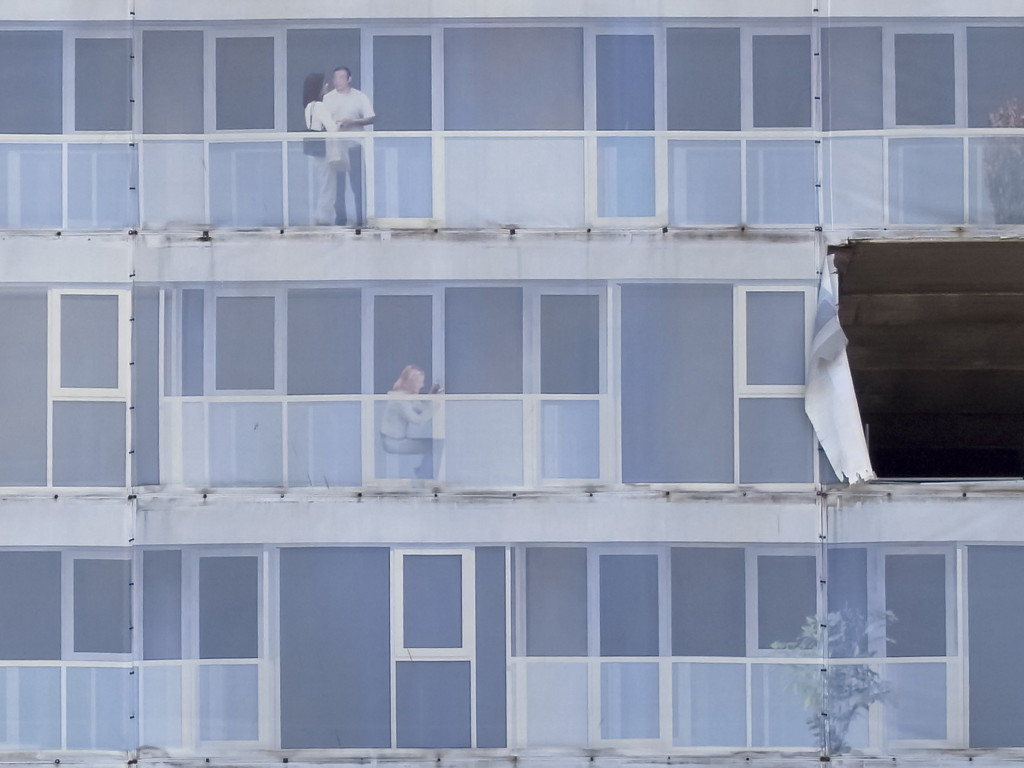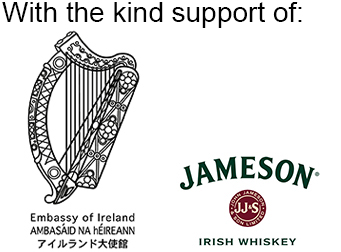A few light taps upon the pane, no one turns, no reply
Suzanne Mooney
27 July – 11 October, 2015
Opening night reception: 27 July, 19:30 – 21:30
.

© Suzanne Mooney, A few light taps upon the pane, no one turns, no reply (detail), 2015. Photographic Image UV direct print on acrylic panel, 160 cm x 120 cm.
.
| アーティストが風景画に興味を持つようになったのは比較的新しい動きと言える。紀元前1500年頃までは風景画の作品は極僅かであった。それが17世紀、オランダ黄金時代の絵画の時代にジワジワと増え続け、ロマン派時代に瞬く間にブームとなる。カメラが発明されてから全てが変わったのは言うまでもないが、ボタン一つで見たものをそのまま再現できる技術にアーティストらは戸惑い、結果、風景画が主となる印象派時代に突入することになる。アーティストらは戸外制作を行い、光の質や色の特徴を今までにないやり方で試みた。
アートとしての写真の世界でも、風景にあらゆる面で執着した。構成や形に重点が置かれ、人間が排除された。私が最初スザンヌ・ムーニーの作品に惹かれたのは、人物が写ることでその風景のバランスが崩れてしまう写真が多い中、彼女の写真には一切そういったことがないからではないかと思う。彼女の写真はレンズを風景に真っすぐ向け、まるで間違えたかのように人物が写っている。その人物は、端に小さく写っている場合もあれば、中央の場合もあるが、写された人物は写真の焦点となることがない。間違っても人物写真とは呼べない、例え写真家自身のシルエットが写真の大半を占めていても。(「Come Away, O’…」, (2012-2013) — 風景が必ず作品のスターなのである。 東京でアイルランド出身のムーニーに始めて出会ったのは、数年前に遡る。彼女がまだ多摩美(東京、多摩美術大学)の博士課程で東京の鳥瞰図を撮っていた頃だ。大都市の景観や現実という概念の思想についてカジュアルな話しをしていく間に、作品を見ずとも彼女の写真に大きく興味を持ったことを覚えている。 彼女の作品を実際に見た時、私は期待を大幅に上回る衝撃を受けた。ユニークな感覚による見事な精密さ、息をのむ程の構成力、そして一つの写真の領域を遥かに超える多重に重ねられた表現力がそこにはあった。彼女が持つディテールへの愛と細部まで追求するパーフェクションを経て、完璧な作品が生み出されていた。情報社会の今日、スマートフォンで高画質の写真を日々撮れるようになった我々も、ムーニーの作品から学べる事が一つや二つあるのではないだろうか。 東京の景観は時にその壮大さに圧倒されてしまうが、ムーニーが写し出す東京はそれを覆すものだ。密接した建物や高層ビルが立ち並ぶ中、世界中どこにでもある、人の普通の生活が描写されている。写真の激しい美しさが人の目を引きつけるが、ひっそりと佇む人物の存在によってどれも哀愁漂う詩的な作品として完成されている。 また、ムーニーの作品に魅了されたのが私だけでないことをとても嬉しく思う。博士課程を終了してからというもの、彼女は多くの名声を浴び続けている。つい先日、イギリスで開催されたAesthetica Art Prize 2015を受賞したばかりだが、2015-2016年度の小金町アーティストインレジデンスにも選ばれている。 1年以上前にもムーニーの作品をThe Containerの展示会に置かせてもらった。彼女の東京の捕らえ方と彼女が当時試していたアクリル判への印画に大変魅力を感じたからだ。今回はそれらの作品の透明感と、彼女の少し前の作品集でLEDのライトボックスを使ったものにとても興味を持った。池袋サンシャインシティからの東京の景観を360度写した作品もその一部だ。(「Tokyo Summit A」 (2012)) キュレーターとして、狭くて暗いThe Containerで写真を展示することに戸惑いはあったが、The Containerを等身大の巨大ライトボックスに作りかえてしまうと言うムーニーの案に大きく創造力を掻き立てられた。 その後、数ヶ月に渡り展示する作品について話し合いを重ねた。東京を長年上から撮る事ばかりしてきたムーニーだが、新しい目線からの写真に挑戦することで合致した。今回の展示会に向けて、二人のイメージはぴったり合っていたのだと思う。 ただその数ヶ月後、展示会についての話し合いの場で、ふとムーニーが数年前にダブリンで撮った写真を見せてくれた。それらには2008年のアイルランドの国家破綻後、建設途中のまま手つかずになった多くの建物が写っていた。その内の一枚が特に興味深かった。完成イメージが描かれた工事シートが覆い被さるスケルトン状の建物だ。現実を必死に隠そうとしているそのファサードは、東京の煌びやかなビルの下に垣間見える現実と大して違わないのではないだろうか。 この工事シートが剝がれかけている建物の写真は、The Containerでの展示会に格別に相応しいのではないかと感じた。我々が目指すべきアイディアを邪魔することなく、かつ、建設物としてのThe Containerの未完成さを上手く共有出来ている作品だと思う。 「A few light taps upon the pane, no one turns, no reply」 (2015) は、The Container特定の新しいインスタレーションであり、スザンヌ・ムーニーの最新作だ。直接印画された巨大なアクリル判がThe Containerを大きく2つに分け、透明と不透明の部分に分かれるイメージに後ろから光を当てることで来場者のシルエットが作品の一部になるようデザインされている。この作品と共に東京のライトボックス及び2010年から2011年に撮影された「Walking in the City」 からの作品を一部展示する。
|
Artists’ interest in landscape is a relatively recent phenomenon. Before 1500 BCE there are very few examples of actual landscape works. This interest took a real turn only as recently as the 17th century during the Golden Age of Dutch painting and bolstered during the Romantic period. Everything changed, of course, after the invention of the camera, with many fine artists perturbed by the new machine that could “create a likeness by a press of a button,” and as a result, gave birth to Impressionism, which made landscapes the main focus of many works— painting outdoors and investigating light and colour, in ways artists never explored before.Photography in itself, as a form of art, became very landscape obsessed, with many photographers making “pure landscapes” where the emphasis is on forms and shapes, and lacks the presence of humanity—depictions that often take documentative impressions of our surroundings. Perhaps, this is what drew me first to Suzanne Mooney’s photographic works, where often the landscape is intervened by human presence. In her works, Mooney directs her lens onto a landscape, but often, almost by mistake, one can spot a figure—sometimes at the edge of the frame and other times more centrally, but never as the focus of the works. You can never call it portraiture photography, even when her own silhouette occupies half of the frame (as in Come Away, O’…, 2012-2013). The landscape is always the real star.
I met Mooney, an Irish national residing in Tokyo, a few years ago, while she was still working on her PhD dissertation at Tamabi (Tama Art University in Tokyo, Japan), focusing on bird’s eye views of Tokyo. Casual conversations we had about urban landscapes, viewing planes of a city, and philosophical interpretation of what may comprise a reality, piqued my interest in her works, before I even got to see any of her photographs. Seeing her works, though, was a revelation—it was her unique ability to interpret a space with admiring precision and accuracy, breath-taking compositions, and layers upon layers of references that extend well beyond a simple photographic depiction. Her technical love for detail and her unforgiving fixation with perfection produce photographs that are apt and faultless. I suppose that especially nowadays, in our information era, where everyone snaps high-resolution photographs regularly with their phone cameras, Mooney can teach us all a lesson or two about photography, as an art form. The urban landscape of Tokyo is overwhelming in its vastness, but Mooney’s interest in everyday activities of passers-by breaks the anonymity that Tokyo is so famous for. It is the realization that behind the dense scenes of buildings, skyscrapers, and architectural features, real people live, work, and go about their lives as normal, as you would expect of anyone else in the world. It is those intense and beautifully framed sceneries that capture the attention when one sees her photographs, but it is the subtle presence of humans that make them poetic and elegiac. I am delighted I am not the only one to have notice and appreciate those elements in Mooney’s works. Since her completion of her PhD programme she has gone from strength to strength. Recently, she has been announced as a winner of the Aesthetica Art Prize 2015 in the UK and also has been selected in Japan to participate as artist-in-residence in Koganecho, Yokohama, 2015-2016. Over a year ago I invited Suzanne Mooney to show at The Container. I was taken by her depictions of Tokyo and by a new process she was experimenting with at the time—direct prints on sheets of acrylic. The transparency of those images, and previous works she created with LED illuminated light-boxes, including a 360 degrees impression of Tokyo’s bird-eye view, shot from the Sunshine City building in Ikebukuro (Tokyo Summit A, 2012) triggered my curiousity. Although as a curator I am fond of photography, I was always shy of showing photographic works at The Container, as the space is so small and dark, but Mooney’s proposal to convert the entire space into a life-size light box, using her direct printing technique on acrylic sheets, really captured my imagination. Over the following few months we had many conversations about the image we should select for the exhibition. Mooney, after years of photographing Tokyo from above, developed an interest in exploring Tokyo from a new plane, and we discussed various locations in Tokyo that she was interested in. I think we were both quite set on the kind of imagery we wanted for the exhibition. A few months ago, however, while we were meeting to discuss the exhibition, she shared with me a series of seemingly unrelated images she shot a couple of years ago in Dublin. They were all portrayals of incomplete buildings in Dublin where the construction abruptly stopped following the collapse of the Irish economy in 2008. One image, in particular, seemed very fascinating – a skeleton of a building concealed behind tarpaulin printed with the image of what the building would have looked like when complete. A façade: an effort to conceal the reality, and not unlike her Tokyo images of dense shiny buildings where a closer inspection reveals a subtle new reality. This new image seemed exceptionally suitable for The Container show, as the deteriorating printed tarpaulin reveals the unfinished building behind it. We both felt that the image would echo well the unrefined construction of the container itself, and theoretically still maintain the same interest we were both fixed on exploring for this show. The new site-specific installation at The Container, A few light taps upon the pane, no one turns, no reply, 2015, (a play on a quote from James Joyce’s Dubliners), is Suzanne Mooney’s latest work. The installation sees a large photographic image in direct print on an acrylic pane that divides the physical space of The Container in two. The image is partially transparent and partially opaque, and back lit, allowing the visitors’ silhouettes to become part of the work itself. Along with this new work we are exhibiting also some of Mooney’s light boxes of Tokyo, including selected images from her series Walking in the City, from 2010-2011.
|
